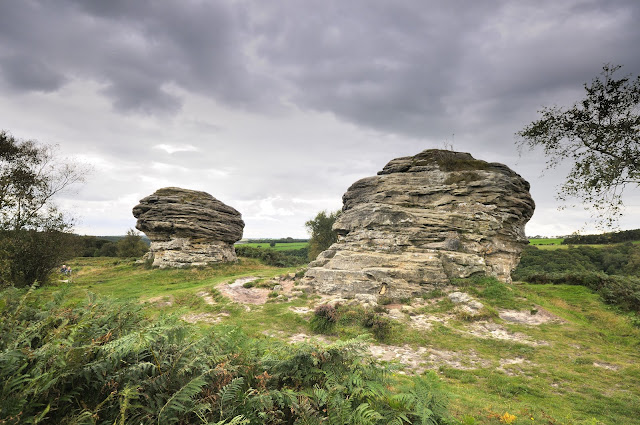The Bridestones, Rievaulx and Hutton-le-Hole
Over a couple of days we explored a few places in the area, as we were new to North Yorkshire. What a fabulous county!. There is so much history and amazing and varied history up this part of England. I think we need longer than our week Anyway, off to Dalby Forest to explore, with one particular place in mind
The Bridestones - a series of "outcrops of millstone grit rocks and boulders which are ½ a mile long. Amongst these rocky outcrops are a number of odd-shaped formations that have been caused by weather-related erosion over thousands, if not millions of years. One huge boulder in particular, known as ‘The Great Bridestone’ is fantastically shaped at its base, looking like an up-turned bottle, as if it might topple over at any moment. There are a number of myths and legends associated with The Bridestones, many of these going back to the mists of time. More recently, perhaps, there are a number of local traditions that have become connected to the place and its many, strange-shaped rocks and boulders."
A great walking area in the Dalby forest. Follow the link above for a more information about this Ancient Site.
One of the most picturesque of the villages in the National Park lies in a natural hollow or hole, hence its name. I believe the current name only dates back to the 19c. A clear moorland stream, Hutton Beck, splashes and winds its way through the pillowy mounds that form the village green, traditionally cropped by the local sheep. A really pretty place to wander which we did for an hour or so, before continuing our explorations

Rievaulx Abbey ruins are magnificent, and I find it amazing that so much of this gigantic site has survived through the centuries.
Rievaulx was the first outpost of the Cistercian Order in the North. At the height of its prosperity under Abbot Ailred, it was one of the greatest Cistercian houses in England. The main monastic buildings, including the abbey church, survive well and retain important architectural evidence of the changing wealth of the community.
In particular, the abbey church contains the earliest large Cistercian nave in Britain and is older than any now surviving in France. (above)
From the time of St Augustine's mission to re-establish Christianity in AD 597 to the reign of Henry VIII, monasticism formed an important facet of both religious and secular life in the British Isles. Settlements of religious communities, including monasteries, were built to house communities of monks, canons (priests), and sometimes lay-brothers, living a common life of religious observance under some form of systematic discipline. It is estimated from documentary evidence that over 700 monasteries were founded in England. These ranged in size from major communities with several hundred members to tiny establishments with a handful of brethren. They belonged to a wide variety of different religious orders, each with its own philosophy.
Shrine to Abbot William, first abbot of Rievaulx (1132-45)
William was a Yorkshire man who responded to St Bernard’s call to join his Cistercian community at Clairvaux, which he called the earthly Jerusalem. William became one of Bernard’s leading men and officiated as secretary of Clairvaux. William was chosen by Bernard to lead the community at Rievaulx, Clairvaux’s first daughter-house in England and the Cistercians’ outpost in the North. He led the new colony of monks from France to Yorkshire, where they established a new community in 1132. William was greatly admired for his devotion and abilities, and consolidated monastic life at Rievaulx. Following his death he was celebrated as a saint and buried in Rievaulx chapter-house. A new shrine was built to accommodate his remains c. 1250, along the western wall of the chapter-house; remains of this can still be seen.











Comments